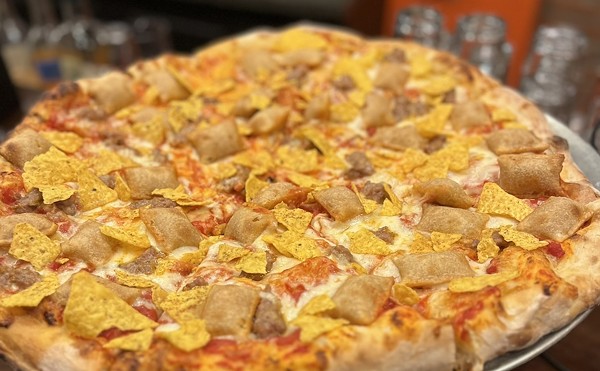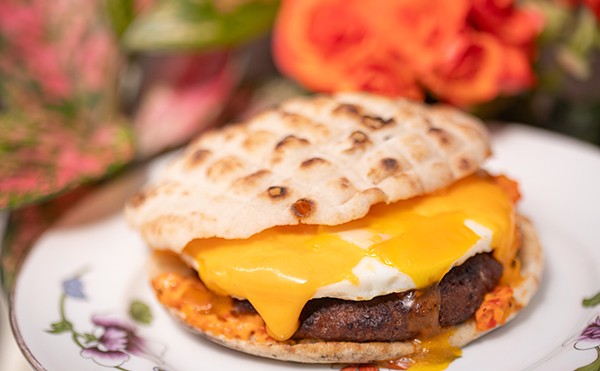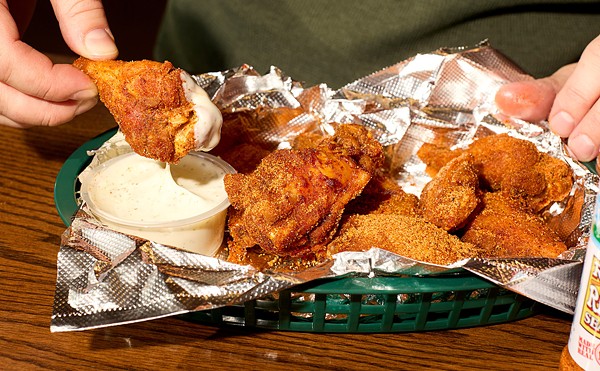Whatever its exact shade, it's a beautiful sauce. I'll let Crayola work out the specifics. Actually, Crayola will have to capture two colors: vindaloo the sauce and vindaloo the nuclear flash that blinds you after each bite. As Flavor of India's menu helpfully points out, vindaloo is "super hot."
Vindaloo is a dish from Goa, a small state on India's west coast, and, for almost 500 years, a Portuguese colony. According to Indian food expert Madhur Jaffrey, original Portuguese "vindaloo" was pork stewed with wine vinegar and garlic; in fact, vindaloo is a transliteration of the Portuguese words for wine and garlic. Indian cooks replaced the pork with other meats — at Flavor of India you can order chicken, lamb, shrimp or fish in a vindaloo sauce — and added heat and, often, potatoes.
Flavor of India specializes in the milder cuisine of north India, drawn from Afghanistan and Persia, but it does offer a wide variety of traditional Indian dishes. I ordered lamb vindaloo in part because I love spicy foods, and in part because I think it's a good litmus test for any Indian restaurant.
Making a dish very hot is relatively simple: Just keep adding chile peppers. I've had vindaloo sauces so scorching that my sinuses didn't bother me for months. I couldn't taste a thing, though. An excellent vindaloo sauce will wallop you with overpowering heat, but it will also have the subtle mixing of spices (many of them not especially hot) that distinguishes Indian cuisine, regardless of the specific region.
Flavor of India's lamb vindaloo was excellent, a heady combination of ginger, cloves, tangy lamb and, of course, chiles. I shouldn't have had any doubts. While Flavor of India opened just three months ago, a spare, dimly lighted space in a strip mall on Olive Boulevard just east of I-270, its pedigree will be familiar to St. Louis diners. The chef and manager held those same positions at House of India, on Hanley Road near I-170, from 1994 to 2005.
I say that the lamb vindaloo tasted of ginger and cloves, but it wouldn't surprise me to discover that the sauce had little or none of each. That's why Indian cuisine is so mesmerizing. The right blend of spices can conjure up a familiar taste, but with a striking variation. A flavor as distinct as ginger or cumin can seem so clear in some dishes, a mere whisper in others.
On my first visit, for example, I tried krahi lamb. This sauce, according to the menu, features "fresh bell peppers, tomatoes, onions [and] ginger in a fine blend of spices." What the "fine blend of spices" might include, I couldn't say. What was remarkable about the dish, though, was how that blend deepened the flavor of the bell peppers, as blunt and uninteresting a vegetable as there is. They still tasted like bell peppers, just more so, giving the sauce the fresh, clean bite of citrus fruit.
On the other hand, the spices blended into baingan bharta softened eggplant's distinctive edge, making it the backbone of a creamy and indulgently buttery sauce. Vegetable korma was more indicative of north Indian cuisine's Afghan and Persian roots, a very mild — almost mellow — mix of vegetables, raisins, cashews and almonds in a cream sauce.
Few flavors can overpower a dish as easily as cumin or cilantro, which made the mulligatawny soup all the more impressive. A dash of each gave the soup quiet notes of toasty sweetness and verdant sharpness. I couldn't find two identical recipes for mulligatawny soup (literally, "pepper water"); at Flavor of India it's thick with lamb and chicken, more a stew than a soup.
Among the dishes I tried, the only disappointment was the ever-popular chicken tikka masala. The friend who ordered this complained it was too salty. It was, but I thought it was also flat-footed: a tomato-based sauce, rounded out by cream and butter, but not as luxuriously creamy or buttery as either the korma or the baingan bharta. It wasn't a bad dish, but once you've tried more complex dishes, it's hard to come back to.
Nearly as straightforward as the chicken tikka masala but more enjoyable were the appetizer selections. I tried the vegetarian appetizer platter, a reasonably sized sampling of deep-fried morsels. Vegetable and paneer (homemade, unaged cheese) pakoras as well as onion bhajia (essentially onion rings) were fried in a chickpea batter dusted with spices. The chickpea batter was lighter than conventional batter but still substantial. Even more substantial was the classic Indian fried food, the samosa, a fat, rounded pastry stuffed with potato and peas.
Like Western fried foods, these are ideal for dipping. At Flavor of India you get a mint chutney — coriander or something similar was very prominent here, too — and a tart, sweet tamarind chutney. Both are excellent. Whenever the waiter removed them from the table to make room for the entrées, I felt a little sad.
(Had I asked him to leave them, he probably would have said yes. The service at Flavor of India is excellent and very friendly.)
After both dinners I had at Flavor of India, I felt like I might have sampled half the menu. In truth I'd barely made a dent. The menu lists more than 70 entrées, not to mention the appetizers, soups, salads, breads (a very nice selection besides the usual nan) and desserts. For those unable to make one choice, Flavor of India, like most Indian restaurants, offers a daily lunch buffet.
When I visited one afternoon, I was pleasantly surprised by the variety of dishes. There were the buffet standards, such as grilled tandoori chicken and palak paneer (cheese in creamed spinach). The palak paneer was very good, just sharp enough (more from the spinach than the cheese) to be addictive. The chicken was good, though I prefer it whisked from the kitchen on a sizzling platter. As it sits on the buffet, it fades to just plain chicken, in need of a dousing of raita or the mint and tamarind chutneys.
There were some unfamiliar choices, however. Tender goat came in a simple, mild curry. Kari pakora were the appetizer-menu vegetables deep-fried in chickpea batter, then tossed in a thick yogurt sauce. I feared the batter would turn gloppy on the buffet, but if it did soften somewhat, it blended right into the sauce. I tasted cumin more than anything else, though I thought I detected a hint of lemon juice — something acidic, at any rate, which made a nice complement to the buffet's predominantly savory dishes. And I dug the color, somewhere between mustard and lemon on the yellow scale.
It too would make a nice addition to Crayola's Flavors of India line. I doubt the crayon company makes a big enough box, though.





